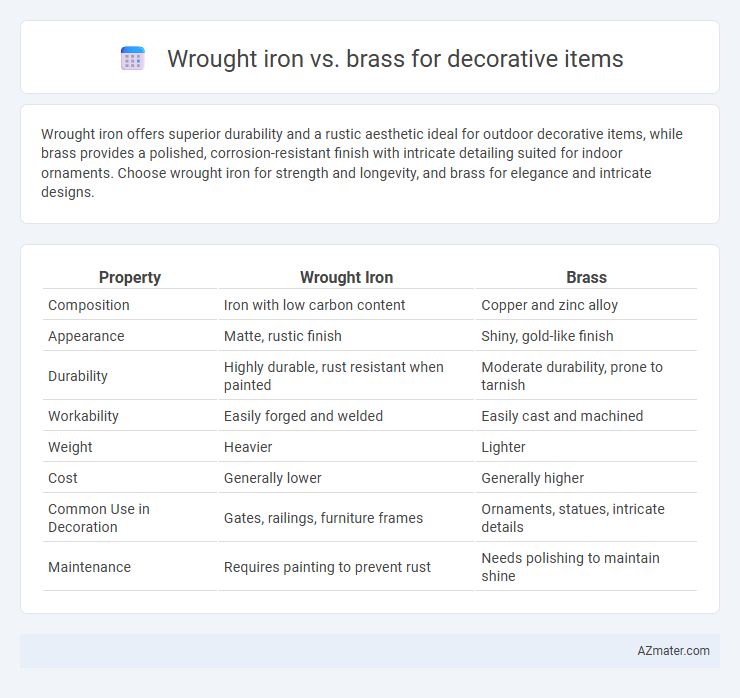Wrought iron offers superior durability and a rustic aesthetic ideal for outdoor decorative items, while brass provides a polished, corrosion-resistant finish with intricate detailing suited for indoor ornaments. Choose wrought iron for strength and longevity, and brass for elegance and intricate designs.
Table of Comparison
| Property | Wrought Iron | Brass |
|---|---|---|
| Composition | Iron with low carbon content | Copper and zinc alloy |
| Appearance | Matte, rustic finish | Shiny, gold-like finish |
| Durability | Highly durable, rust resistant when painted | Moderate durability, prone to tarnish |
| Workability | Easily forged and welded | Easily cast and machined |
| Weight | Heavier | Lighter |
| Cost | Generally lower | Generally higher |
| Common Use in Decoration | Gates, railings, furniture frames | Ornaments, statues, intricate details |
| Maintenance | Requires painting to prevent rust | Needs polishing to maintain shine |
Introduction to Decorative Materials: Wrought Iron vs Brass
Wrought iron offers durability and a rustic, antique aesthetic favored for outdoor and vintage decorative items, characterized by its high tensile strength and corrosion resistance. Brass, an alloy of copper and zinc, provides a bright, gold-like appearance with excellent machinability and resistance to tarnishing, making it ideal for intricate indoor decorative pieces. The choice between wrought iron and brass depends on the desired visual effect, environmental exposure, and maintenance requirements in decorative applications.
Historical Significance of Wrought Iron and Brass
Wrought iron has been historically valued for its durability and ornamental appeal since ancient times, prominently featured in medieval and Victorian architecture for gates, railings, and furniture. Brass, an alloy of copper and zinc, gained significance during the Renaissance and Industrial Revolution for its corrosion resistance and bright gold-like appearance in decorative hardware and musical instruments. Both materials hold distinct cultural legacies: wrought iron symbolizes strength and craftsmanship, while brass represents elegance and artistic innovation in decorative arts.
Aesthetic Appeal: Visual Differences
Wrought iron offers a rustic, timeless aesthetic with its dark, matte finish and intricate, handcrafted patterns that evoke a vintage or industrial charm. Brass provides a warm, golden sheen that enhances decorative items with a bright, polished, and elegant appearance, reflecting light and adding a luxurious touch. The visual contrast between wrought iron's sturdy, textured surface and brass's smooth, shiny finish makes each material distinctively suited for different decorative styles.
Durability and Longevity Comparison
Wrought iron offers exceptional durability and longevity due to its high tensile strength and resistance to wear, making it ideal for outdoor decorative items exposed to harsh weather conditions. Brass, while resistant to corrosion and tarnishing, is softer and more prone to scratches and dents over time, impacting its long-term structural integrity. For decorative applications demanding robust endurance, wrought iron outperforms brass in sustaining aesthetic appeal and functionality over extended periods.
Maintenance Requirements of Wrought Iron and Brass
Wrought iron requires regular maintenance, including cleaning to remove dust and moisture, as well as periodic application of rust-resistant coatings to prevent corrosion and preserve its durability. Brass is low-maintenance, needing occasional polishing to retain its shine and prevent tarnishing caused by oxidation. Both materials benefit from protection against environmental elements to extend their lifespan and maintain aesthetic appeal in decorative items.
Versatility in Design and Applications
Wrought iron offers exceptional versatility in design with its ability to be shaped into intricate patterns and robust structures, making it ideal for both indoor and outdoor decorative items such as gates, railings, and furniture. Brass excels in applications requiring a bright, gold-like finish and detailed craftsmanship, often used in smaller decorative pieces like lamps, handles, and artistic accents due to its malleability and corrosion resistance. Both materials provide distinct aesthetic qualities and functional advantages, with wrought iron favored for structural complexity and durability, while brass is preferred for elegance and fine detailing.
Cost Factors: Wrought Iron vs Brass
Wrought iron typically costs less than brass due to its abundant raw material availability and simpler manufacturing process. Brass, an alloy of copper and zinc, commands higher prices because of fluctuating metal market values and more complex casting methods. When choosing between the two for decorative items, the budget significantly influences the decision, with wrought iron offering a more economical option while brass provides a premium aesthetic.
Environmental Impact and Sustainability
Wrought iron offers high durability and recyclability, making it an environmentally sustainable choice for decorative items due to its low energy consumption during recycling. Brass, an alloy of copper and zinc, requires intensive mining processes that have greater ecological footprints but can be recycled indefinitely without quality loss. Choosing wrought iron reduces environmental impact through long lifespan and efficient recycling, while brass demands more resource extraction but supports circular use if properly recycled.
Popular Decorative Items in Wrought Iron and Brass
Popular decorative items in wrought iron include ornamental gates, railings, furniture, and chandeliers, prized for their durability and intricate designs. Brass is commonly used for decorative items like candle holders, vases, door handles, and sculptures, valued for its bright gold-like appearance and resistance to tarnishing. Wrought iron offers a rustic, heavy aesthetic ideal for outdoor decor, while brass provides a polished, elegant look suitable for indoor accents.
Choosing the Right Material for Your Decorative Needs
Wrought iron offers durability, a rustic charm, and weather resistance, making it ideal for outdoor decorative items like garden gates and furniture. Brass provides a bright, golden appearance with natural corrosion resistance, perfect for indoor decor such as lamps, statues, and intricate ornaments requiring a polished finish. Choosing between wrought iron and brass depends on the desired aesthetic, placement environment, and maintenance preferences to achieve the best visual impact and longevity.

Infographic: Wrought iron vs Brass for Decorative item
 azmater.com
azmater.com